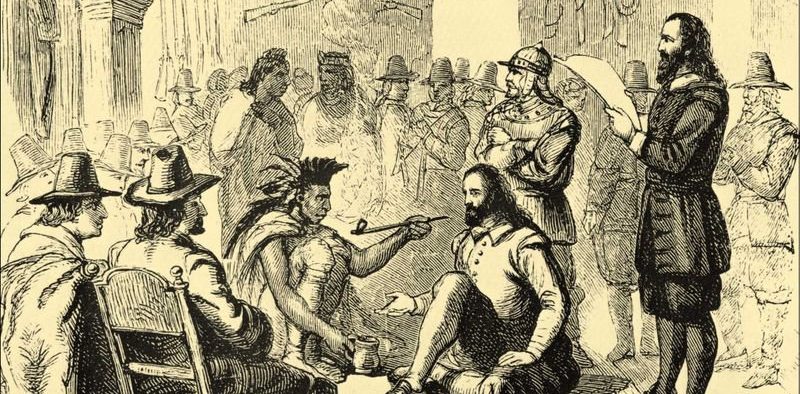The Real Thanksgiving Story
Share

Long before The Karens waved their keto wands and masterfully crafted the paleo pumpkin pie, and the Soccer Moms took cutesy photos of bonnet cladden babies posed as pilgrims, Thanksgiving was an actual, historical occasion. Your inner November-induced American patriot might be screaming, “I know that!” as you huddle around a long, candle-decked, holiday-food-stuffed table flaunting Native American garb. But what if I told you that what you’ve come to know as Thanksgiving’s origin story is actually a fable?
American schools paint a rosy picture of the first Thanksgiving. The black buckled hat sported by the “original American” men might be the only thing you remember from elementary school history classes as a kid. However, much like the rainbow-and-puppy version of the Thanksgiving story we’ve all been fed–no pun intended–those outfits are far from the true story. In most elementary school history lessons, the narrative actually sounds more like a watered-down version of West Side Story set in the 1600s than a real historical occasion. I mean, think about it: Native Americans, who haven’t had any experiences with people outside their communities, much less European civilization, share a fantastical feast of dishes (that were actually foreign to American soil btw) with strange people who have encroached on their territory. How is that for a fairy tale? We, people in the modern-day 21st century, can’t even stop bickering with our family members long enough to enjoy a cordial Thanksgiving dinner. Yet we believe that they could?…Right…
The colonists didn’t even invite the Native Americans to their festivities in the first place as the traditional story claims. The Wampanoags showed up, unbidden after hearing gun-fire that the English shot off in their revelry. Only after the Wampanoags ran in fear to the scene–interpreting the gun-shot as a threat of war– did the Pilgrims extend an invitation.
Even though the relationship between the Wampanoag and the Colonists did not start as smoothly as the fairy tale of a story depicts it, the Wampanoag and the English did eventually form an alliance. Shortly after the serendipitous meal, the Wampanoag signed a peace treaty with the colonists. This alliance resulted in unique cooperation between the Natives and the Colonists, which is what is brought to mind when one thinks of the first Thanksgiving. However, this peace treaty was not the merry result of good-will like the Pilgrim historical accounts make it out to be. Rather, the Wampanoag partnered with the English (selling them furs for metal tools) as a way to gain leverage and insight into the people that brought disease and violence to their land. Even this alliance was short-lived. When Tisquantum, who you may know as Squanto, boarded the English settlers’ trading ship as part of the deal, he along with 20 other natives were double-crossed, stuffed below deck, and sold to Spain as slaves.
After this event, trade between the Wampanoag and the English continually resulted in blood shed. The alliance slowly frayed through years of raids, cultural clashes and tensions that eventually led to Metacom’s War, one of America’s most devastating conflicts. The war resulted in the death of an estimated 40% of the Native population.
The harmonious story we all tell about the first Thanksgiving was a sliver of peace sandwiched between times of blood and division. However, unlike others who have written on the inaccuracy of the story of the first Thanksgiving, I don’t believe that Thanksgiving dinner should be canceled henceforth.
It is true that the first Thanksgiving contained more bad blood than brotherly love and involved more conflict than bread-breaking. The peaceful story we continue to tell actually resulted in grim, gorey, death. But in a lot of ways, Thanksgiving remains this way to this day. Momentary peace still leads to inner-generational conflict as we all grow up, move out, and form our own belief systems. Our modern family Thanksgivings haven’t resulted in a Civil War, yet, but they are still chock full of hate. Families often don’t welcome members with different political views into their homes. When they do, they take a forced family photo for Facebook, then gossip about the ostracized members as soon as they leave. I think that we’ve crafted and celebrated a fabled Thanksgiving story of peace because we wish it were true. We wish the slim, false narratives of peace with our family members were the real story, rather than the tension that resumes after the holiday season is over. We carry on a fabled tradition because it gives us hope that present, familial strife doesn’t have to continue cyclically, generation after generation.
Peace was elusive in America during the 1600s, and this continues to be the case at Thanksgiving dinner tables today–but this shouldn’t be so. This year, as we pass the mashed potatoes around our 21st century pumpkin-spiced tables, let’s remember the true version of the First Thanksgiving: one in which peace was swallowed by hatred, violence, and war. Let us work to remain in holiday-induced good graces with our family long after the turkey leftovers are finished and the Christmas lights are packed away. This year instead of huffing snide remarks towards your relatives over coffee and pie, effectively work to solve your differences. Genuinely enjoy each other’s company. Let this be the year that your familys’ annual Facebook smiles are authentic, rather than forced. Happy gobbling!
